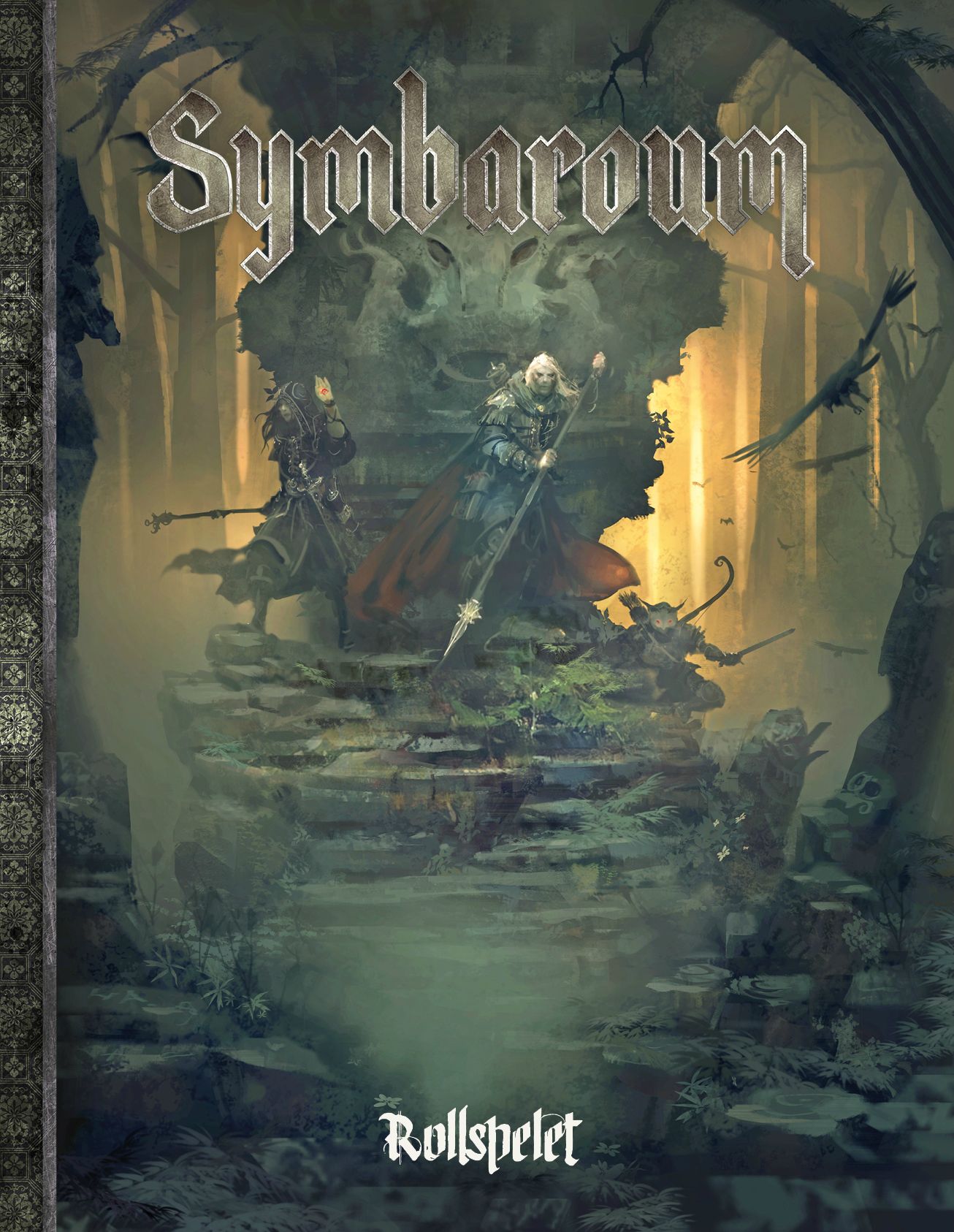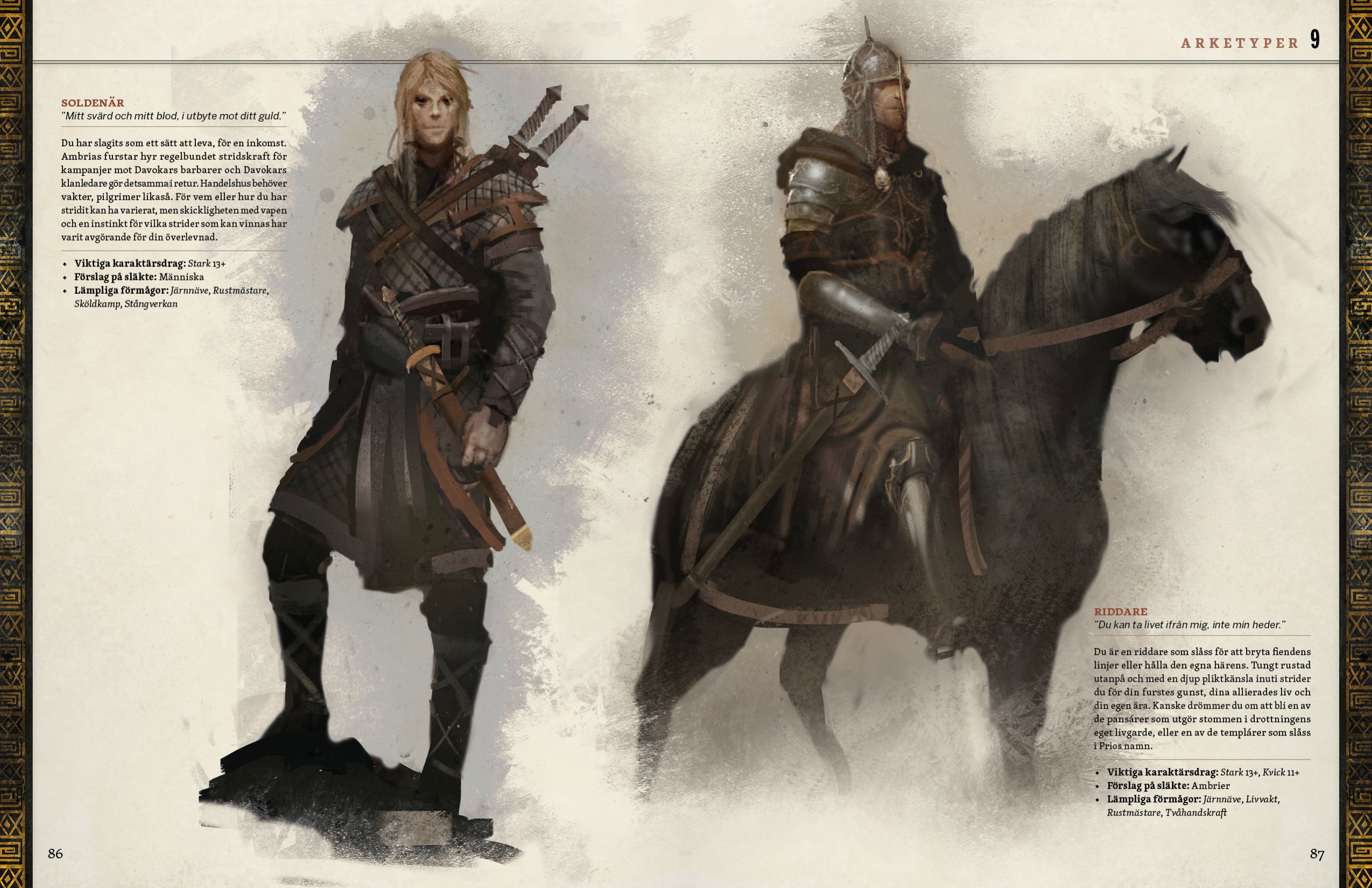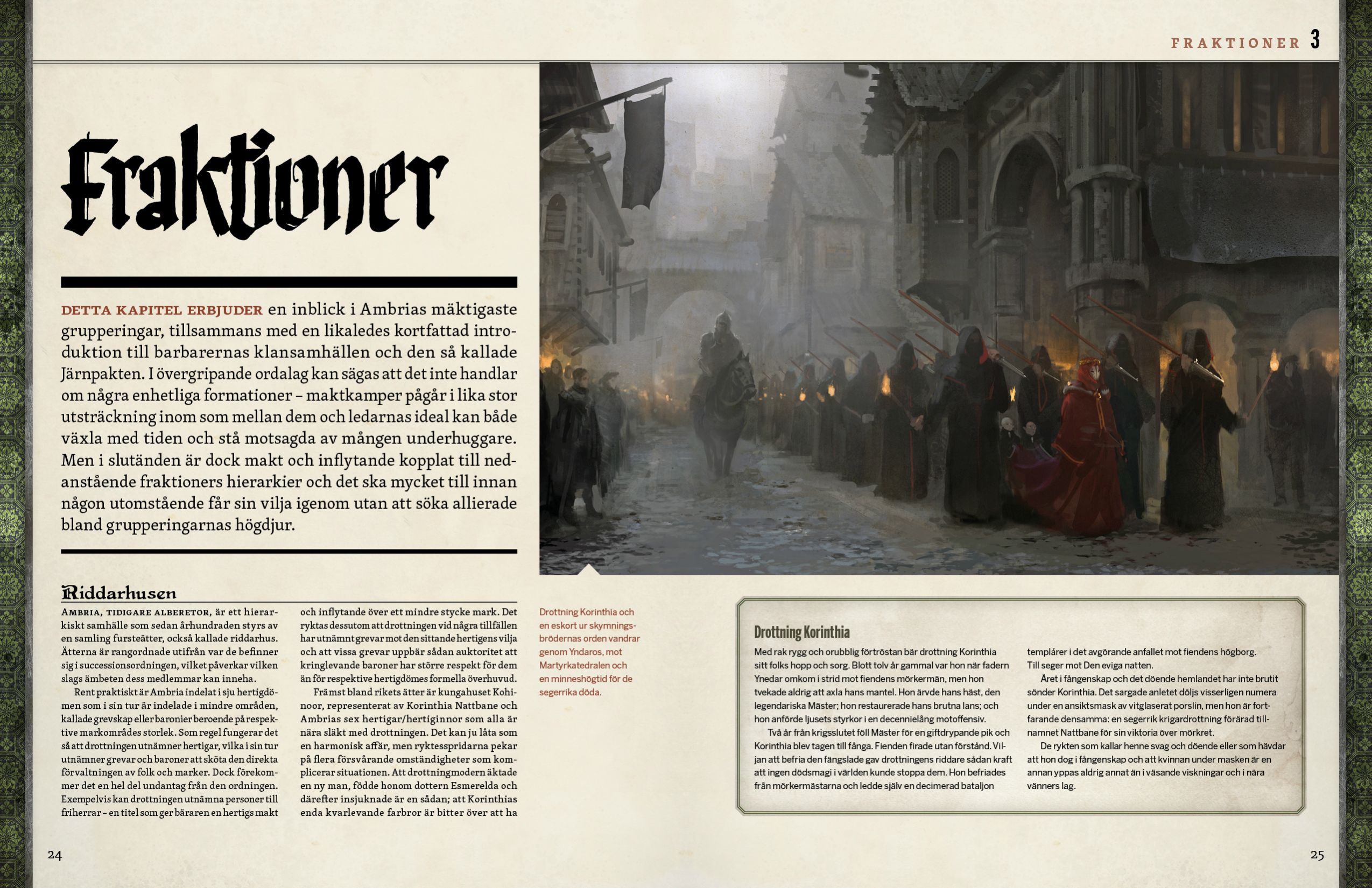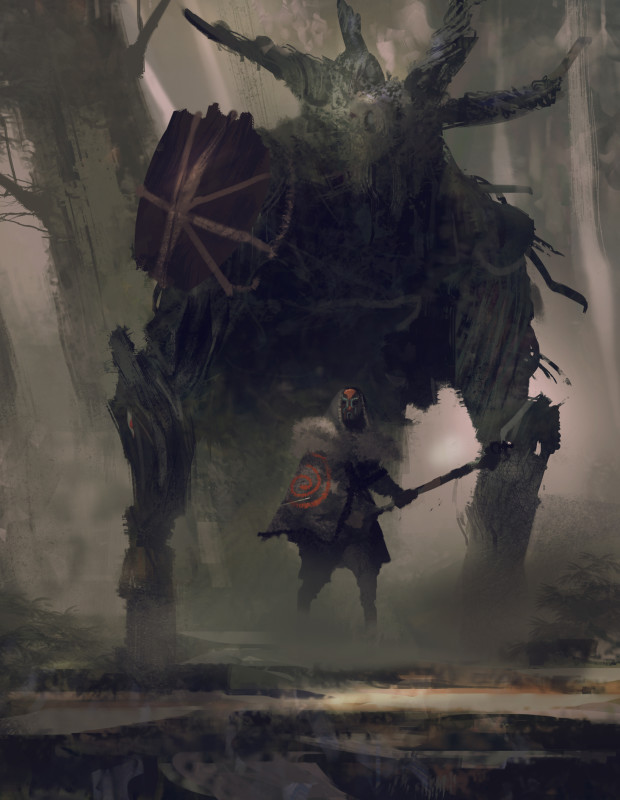
Symbaroum RPG: „The witches of the barbarian clans can sometimes be seen riding and fighting alongside the mysterious beasts known as Colossos – huge ox-like creatures with bodies made up of what seems to be wooden fibers.“ (Image: Järnringen)
Järnringen. Last summer, I found an announcement for a new Swedish dark fantasy roleplaying game called Symbaroum.
Unfortunately, I don’t speak this language, but I liked the gorgeous artwork and the clean layout of the preview material. Some research and online translations later, I knew that I wanted a translation of this game. The descriptions of the highly focused and sinister game world full of corrupting magic and the rules-light approach appealed to me. The hints of the obviously Miyazaki-inspired (Nausicaä, Princess Mononoke) nature vs. civilisation conflicts with human hunting elves and mysterious changelings confirmed my good first impression.
Now, there is an Indiegogo fundraiser to speed up the English translation and worldwide release of the Symbaroum tabletop RPG later this year. Prometheus Games also set a German translation to release Spring 2016. Personally, I prefer English versions of international games. Thus, I pledged some money. I have no further affiliations with the team.
After the following atmospheric teaser trailer Mattias Johnsson, producer and lead writer, Mattias Lilja, Game Designer and CEO, and the graphic designer Johan Nohr answer some questions regarding their Symbaroum RPG and the current crowdfunding campaign.
Please give us a brief overview about your Symbaroum RPG?
Someone once described the game as a mixture of Game of Thrones and Princess Mononoke, meaning that Symbaroum is a game where authentic, believable people (GoT) are involved in struggles related to the conflict between civilization and nature (Mononoke). And that actually captures the heart of it. Both the setting and the ruleset are designed with the aim of depicting “real” people (if sometimes in the shape of goblins, ogres or elves) struggling with “real” issues related to things we all can relate to – ambition, greed, self-interest and social conflicts. The main question being: What would happen, and how would it appear, if nature had the ability to directly respond to civilization’s desire to cultivate and exploit it? A pretty neat basis for building a fantasy game, if you ask us!
What are in your opinion the most important features of the setting and the system?
Starting with the system I would say that the most important aspect of the ruleset is how it allows the players to handle all dice rolls. I would also like to mention the very flexible procedure for character creation. Sure there are archetypes, occupations and races. But instead of dictating what abilities and traits are available to the PC, they function as mere recommendations. You can just as easily take your point of departure in a specific ability, a preferred piece of equipment or a mystical ritual when crafting your PC.
Regarding the setting it has been designed to be a breeding ground for intrigues, conflicts and adventure. It covers a fairly limited geographical area, allowing for a more detailed and deep-reaching design – a design based on relations rather than on single entities (i.e. we create the relation/conflict first, then make decisions on what phenomena represent different aspects of that conflict). So, when you look at the map you may not be impressed by the scope of it. On the other hand, when visiting the streets of Yndaros or the outskirts of the forest you will find that the map gives a false impression.
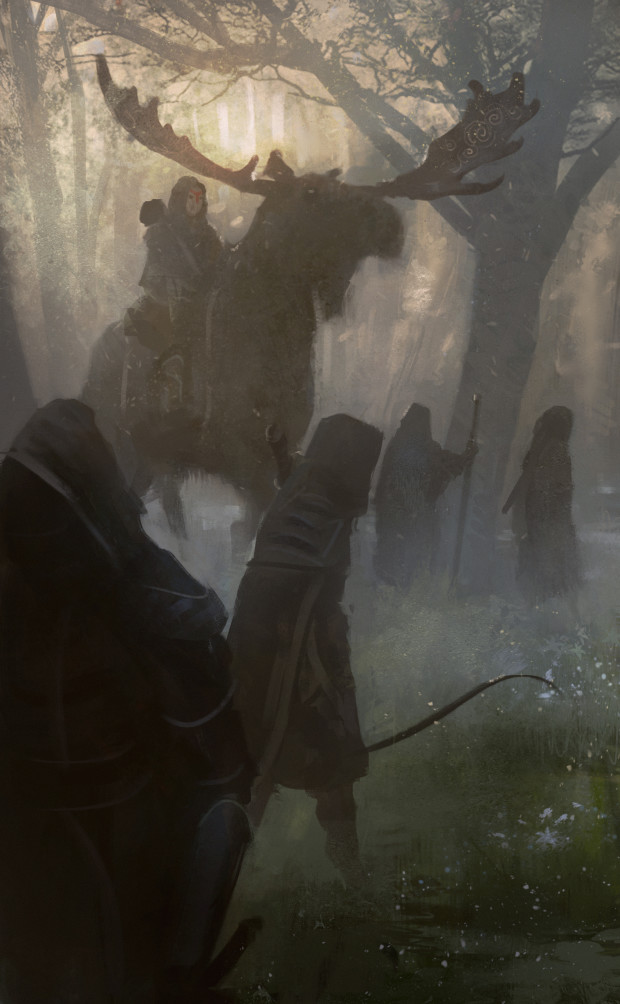
Symbraoum RPG: „According to the elves of the Iron Pact the human race once vowed never to set foot in the deep of Davokar again. They also claim that they are obliged to kill all humans who violate that promise.“ (Image: Järnringen)
The forest of Davokar is indeed a massive and varied „plot of trees“, with an eventful history (to say the least) and inhabited by a multitude of creatures (of which none is very enthusiastic to welcome adventurers, except as additional game). And Davokar is far from everything. First and foremost there is the expansionist realm of newly arrived refugees south of the forest (Ambria) – fighting amongst one another as well as with local factions (for instance 11 barbarian Clans and the hostile elves of the Iron Pact) over the treasures and resources of Davokar. Then you have the mountain ranges (the Titans and the Raven), the plains west of the forest and all the rivers running to or from the great Lake Volgoma. Oh, did I mention the World Beneath? No, and maybe that can wait till another time …
Based on your project description and answers to questions there are still some discussions about the system. How many modifiers have the players to handle for a roll usually (combat/non-combat) and how do you achieve “A typical combat scene should take no more than 30 minutes to run its course.“?
Typically there is only one modifier (the enemy’s attribute-bonus) that affects the player’s dice roll. If the player attacks, the modification would be [player Accuracy, minus enemy Defense). High-quality weapons may add a positive modifier and certain situations may do the same, but generally the enemy stat is the only modifier. Abilities usually do not affect the chance to succeed, but rather the effect of a hit (usually improving damage or adding a hindering condition to the target).
By design the combat system favours aggressive play, and most powers that players and enemies have access to improve damage or inflict debilitating effects. The defensive tricks are fewer and though useful they will not save you for long: many defensive measures also have the potential to hurt or impede the attacker. In short, in Symbaroum the best defense is a strong offense.
During our extensive playtests we found that an average fight for a four player party took about 30 min. The game is not necessarily deadly, as the standard rules for dying are fairly forgiving – going down is easy, while dying is not. However, there are lots of alternate rules for groups to choose from in a modular fashion, one of them making the game a lot deadlier, if that is how the group likes it.
A more subtle killer is the corruption system that creeps up on the unwary as they use mystical powers or artefacts. It’s tempting to accept too much corruption for the sake of power, but that’s like sliding down a slippery slope. From the dark abyss of corruption there is no escape.
There are some considerable hints that you work with some kind of metaplot. Please tell us a bit more about the backstory of Symbaroum.
You know, we grew up with grand campaigns like the Enemy Within, the Four Seasons, Masks of Nyarlathotep and the Swedish equivalent Svavelvinter (by Erik Granström). And should you ask a Swedish gamer about Järnringen, there is a good chance he/she would mention Undergångens Arvtagare (the Heirs of Doom), the huge adventure chronicle we made for our version of the brand Mutant (now licensed by the Free League). So … Yes, Symbaroum does have a metaplot and, yes, there is a majestic series of adventures coming up. In fact, Part 1 Thistle Hold – Wrath of the Warden has already launched in Sweden and is featured among the stretch goals of the fundraiser. Regarding the backstory, I believe you will get the picture by reading the texts and browsing the gallery on the fundraiser page (we shouldn’t make this interview longer than necessary, right?)

Symbaroum RPG: „The ogres emerge fully grown from the depth of Davokar, without memories, without names and without a language to make themselves understood. It is up to the humans who take them in to name them and teach them the ways of the world.“ (Image: Järnringen)
What can supporters of your Indiegogo fundraiser expect to see as far as races, abilities, powers, etc.?
Featured in the Core Book are four playable races: Humans, goblins, ogres and changelings. The humans belong either to the civilized and expansionist Ambrians or to the more down-to-earth Barbarians, the former just having arrived to the game setting and the latter having lived there for centuries. The goblins are wild by nature but are trying to adapt to the Ambrian society where they have found a place as (slave) labourers, while the ogres are brutish humanoids of unknown origin (they literally come walking out of Davokar void of memories and skills, and needs humans or goblins to teach them everything). Lastly, the changelings – mysterious individuals descending from the elven race, that are outsiders wherever they show up.
As for powers, the different races have access to various racial TRAITS. To keep it simple, the changelings can learn to master a kind of shape shifting ability; the ogres often have a more Robust physique while the social privileges of the Ambrians can give them certain advantages. Every character will also learn ABILITIES – representing their unique skill set, letting the player use Symbaroum’s base mechanics in very different ways. For instance, anyone can use a shield to block a sword or an axe, but someone trained in the ability Shield Fighting can use it as a weapon and bash foes to the ground. The abilities also include Mystical Powers (Spells) and Rituals, the latter being mystical powers with a focus on problem solving. You can read much more on this in the Quick Guide which is downloadable from the fundraiser page.
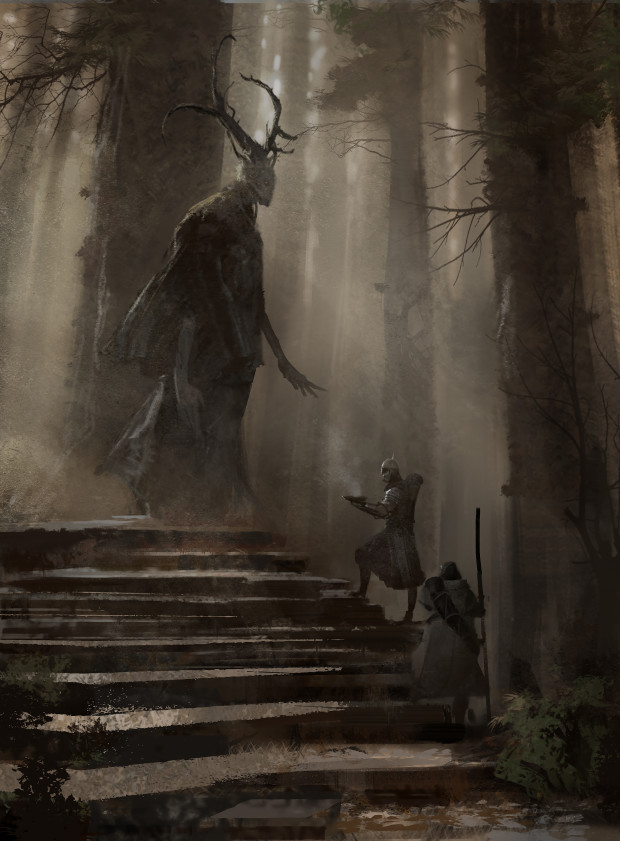
Symbaroum RPG: „In a towering grove at the southern edge of Karvosti (the ancient meeting place of the barbarian clans) lives Aloéna. The ten feet tall female being, assumed to be related to Davokar’s elves, seems to regard humans as if they were nothing more than a passing flock of birds.“ (Image: Järnringen)
There are playable changelings characters in Symbaroum? What about the “elves of the Iron Pact” or “Aloéna, the ten feet tall female being”. How do you play an elf (descendant) appropriately in your game?
The quick answer: You don’t! The elves of Davokar occupy roughly the same role (or function) as the orcs do in your typical fantasy setting. They are the default enemy, more or less rabidly determined to keep all humans out of the woods. The members of the Iron Pact even claim that they have the right and obligation to kill anyone who violates the ancient treaty which has given the Pact its name. The changelings are, as you say, descendants of the elves – swapped for human infants right from the cradle and left to be brought up by humans. Why the elves do this is a mystery, both to the changelings and the humans who raise them in the belief nothing has happens (the child changeling is disguised by an innate mystical power making them appear human up to a certain age). But when their true nature is revealed they are most often thrown into the streets and left to fend for themselves – maybe as thieves in the allies of Yndaros or as fortune-hunters in Davokar.
However, I probably should mention that there is a source book taking shape on our drawing board, a Player’s Guide. And it wouldn’t come as a complete surprise if that module opens up for the possibility to play as one of the few elves who actually are in search for more peaceful solutions to the conflict between elf and man …
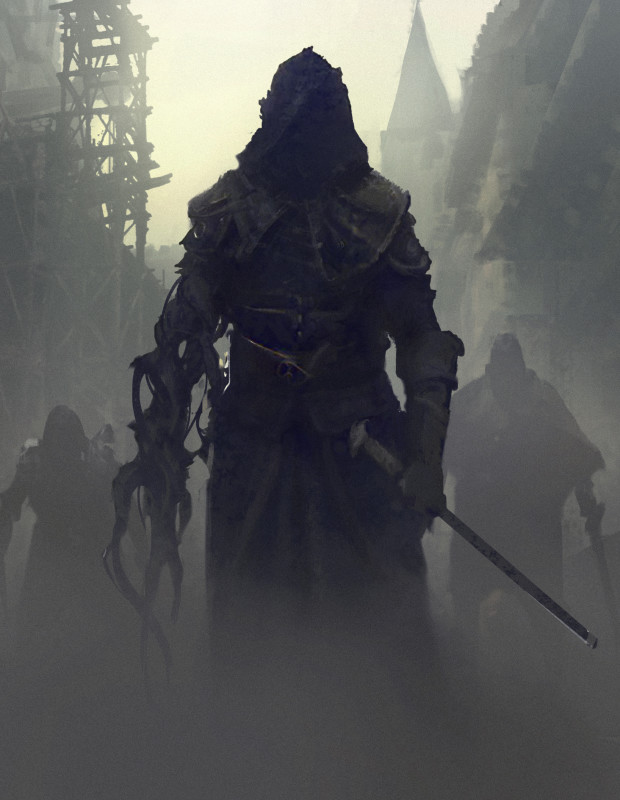
Symbaroum RPG: „If the spiritual corruption runs too deep it will affect not only the mind but also the body. It can happen to anyone anywhere, also in cities like Yndaros and Ravenia.“ (Image: Järnringen)
Magic has definitively a “dark vibe” in Symbaroum. When someone uses mystical powers – rituals or artefacts – they are subjected to spiritual corruption, which can turn them into a “raging madman”. How does this part of system work?
Magic in Symbaroum is powerful and extremely dangerous, for everyone involved. Whenever you use a mystical power, ritual or artefact, you are at risk of being tainted by corruption – nature’s way of responding to the warping and twisting abuse that is magic. Being subjected to corruption darkens your soul and the aura-like shadow that every creature has. Also, every character has a Corruption Threshold, representing the amount of spiritual corruption that he or she can withstand before things go south.
Whenever the corruption level reaches the threshold, it begins to show physically – you can grow horns, get wounds that never heal, or perhaps you start to thirst for lukewarm blood. Temporary corruption fades away at the end of the scene, but you do best to avoid amassing so called Permanent corruption. As the name indicates the taint of the latter kind is much harder get rid of (there are a few rituals and mystical artefacts, but using them is not entirely safe). And the higher the permanent corruption, the more likely it is that the temporary kind will push the PC over the threshold or, even worse, bring it up over the double threshold value. When that happens the PC is forever lost, warped into a raging blight beast.
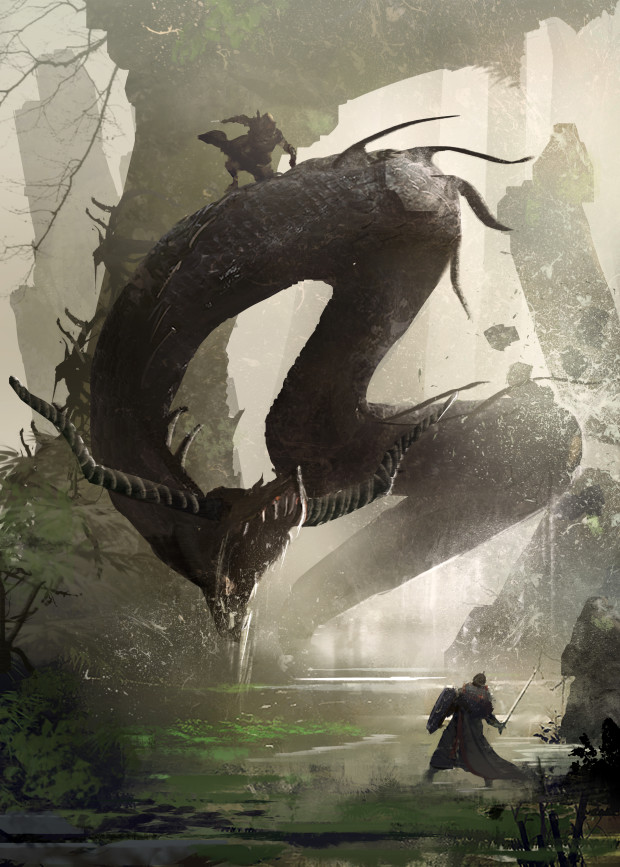
Symbaroum RPG: „The Lindworm is one of Davokar’s most feared creatures. The few Ambrians who have encountered one and returned to tell about it describe them as ferocious but cunning, even as intelligent. Maybe there is some truth to the rumor that the Gaoia clan is secretly ruled by a Lindworm called Uncle Lint.“ (Image: Järnringen)
How would you describe a typical Symbaroum “adventure group” and what are typical threats that they will have to oppose?
As previously mentioned, Symbaroum lets you build whatever PC you like, with few restrictions. The game does offer three archetypes (warrior, mystic, thief) and many occupations for each (gladiator, witch, treasure hunter for example), as a guide to players. It is recommended that each group has abilities that cover the main areas of melee, ranged fighting, problem solving and leadership. In the typical group the warrior is the melee specialist and possible leader; the thief often use ranged attacks and/or sneaky melee and may be a solid problem solver. The mystic can serve multiple purposes, as damage dealer, healer, problem solver or a combination of those.
The threats of the setting are varied, but a classic case is the treasure hunt in the brooding forest of Davokar, complicated by intrigues rooted in more civilized areas. Several factions are interested in what lies under the shadow of mighty trees; robbers and competing treasure hunters wants the treasures for themselves and the Queen’s rangers are there to extract a toll on all who harvest the fruits of the forest. Other enemies might consist of insidious cultists, ravaging trolls and, of course, the blight-stricken creatures that are born out of ignorant or cold-hearted exploitation of the land. Some of the latter appear in human or near human form; others are abominable creatures with nothing but hunger in them. Elves feature as a frequent enemy of treasure hunting PCs, as they and their allies in the Iron Pact are sworn to keep the old evil of Davokar at bay. The PCs may ally with any of the aforementioned, or go their own way in the search for riches and glory.
I heard at least some members of the Symbaroum team are working in the computer game industry. How did this influence your game? What are some of the major lessons you have taken from these experiences?
Something we learned is that fewer modifiers with a clear impact make systems easy to learn and use. Tactical depth comes from combining different player actions and movement on the battlefield rather than stacking abilities and items on top of each other. Other than that we have learned a thing or two about want NOT to do. Symbaroum strives to enhance those things that computer games do not do very well – playing should be a highly social experience; the story should develop on the basis of player initiative rather than on some prefabricated chain of events; and all in all the game should be easily modifiable according to each group’s preferred style of play.
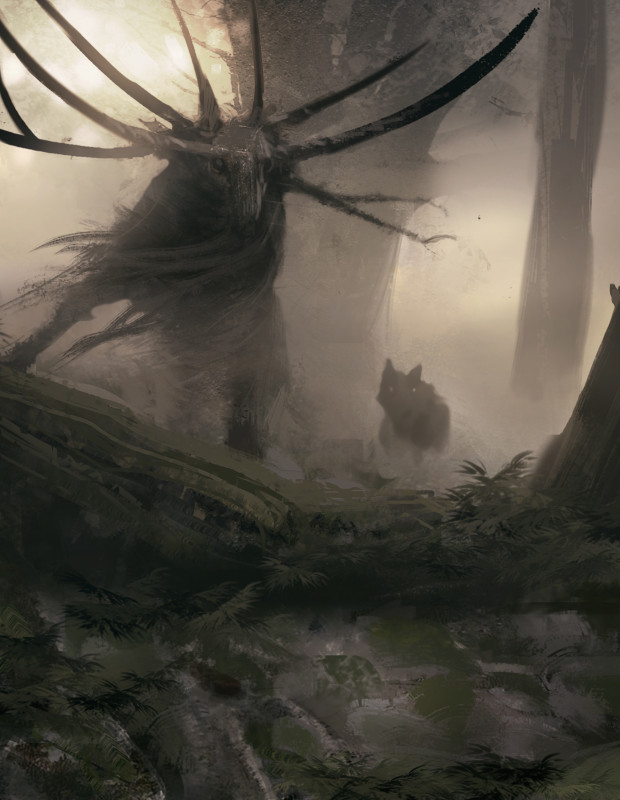
Symbaroum RPG: „They are called abominations, the blight-stricken creatures that have been twisted by the corrupt powers of Davokar. Some of them were once humans or beasts, some came into being during the age of Symbaroum, others are said to have walked the earth since the dawn of time.“ (Image: Järnringen)
Among other inspirations you mentioned Apocalypse World. Players roll all dice and the GM controls the sandbox. The Swedish Mutant: Year Zero RPG has also some similarities to the game by Vincent Baker. One strong point of Mutant: Year Zero are the small and flexible “story points” (places of interest) that every GM can use easily. Which resources and tools does Symbaroum offer to make the GM’s job easier?
Symbaroum presents a sandbox on several levels for DMs to utilize as they see fit. When creating PCs the players select a goal for the characters, and the group also decides on ambitions for the PC party as a whole. On the world level we provide factions with goals that might coincide with the party’s (potential allies), or go against them (possible enemies).
The guidelines for adventure building are easy to follow, and taken together with the rules for challenges [a) set a difficulty, b) pick enemies that correspond to that challenge] the DM can quickly design many adventures around the party’s goals – or go a more classic route and have a quest giver approach the party and ask for aid in return for something the party really wants.
When we write official adventure modules we make them a part of the living setting, with room for the PCs to maneuver and tons of plot hooks to keep them going. Of course, the plot hooks may also be used by the GM to design adventures of the more classical type.
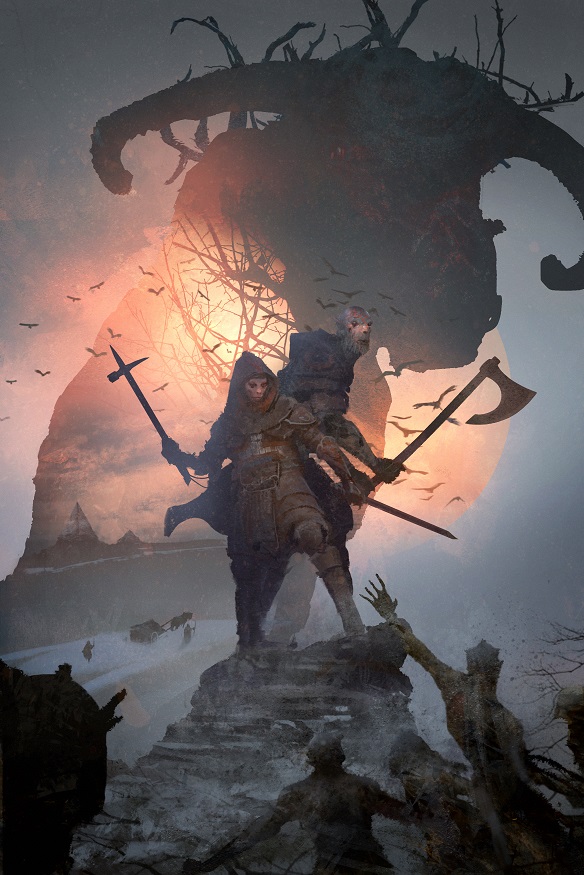
Symbaroum RPG: Thistle Hold – Wrath of the Warden: The Chronicle of the Throne of Thorns, Chapter One (Image: Järnringen)
After the Indiegogo fundraiser, what kind of further development can supporters expect for Symbaroum (- even if the crowdfunding fails)?
We firmly believe that Symbaroum can make an impression on the international TRPG scene. If that happens we intend to live and breathe Symbaroum! On the fundraiser page there is a header called the Future, below which we describe what might happen over the next couple of years. In the long run we have a lot of additional concepts waiting to take shape (not all of them TRPG related). And should the fundraiser fail to reach its target … Well, in that case our ambitions won’t change, but it will take considerably longer before the Player’s Guide, the Game Master’s Guide, the seven parts in the chronicle of the Throne of Thorns and all other products are launched. And that would, at least in our minds, be kind of a shame.
Why do you think backers should support your Symbaroum Indiegogo fundraiser right now?
Our fundraiser project is a pretty straight forward one. Sure there are some special products among the pledge rewards, but mainly it functions as a preorder campaign – you select what type of book quality you want (pdf only, softback, hardback or premium color hardback), and what funds remain after printing goes directly to fund the translation, editing and proofreading. Having the project run on so called Flexible Funding lets us put the funding to good use directly, instead of having to wait till the campaign has ended.
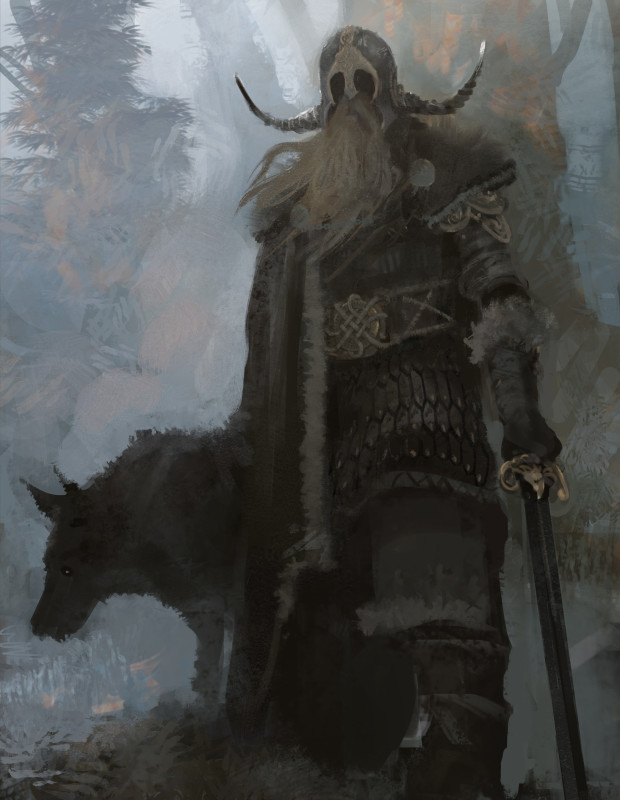
Symbaroum RPG: „Chieftain Embersind of clan Odaiova is sometimes seen in Thistle Hold, always in the company of his battle-trained jakaar. The territory of his clan lies between Karvosti and Thistle Hold, making him the barbarian leader who has developed the closest relations to the Ambrians.“ (Image: Järnringen)
The main reason for supporting us now is that the further we land from our target, the longer the translation will take – and who wants to wait longer than absolutely called for? The second reason is that the more support we get, the more products will be unlocked for translation. And believe me, you don’t want to miss out on Thistle Hold – Wrath of the Warden, the first part in the Throne of Thorns …
Finally, how would you describe the Swedish hobby scene?
To make the answer as brief as the question, I would say “small but vibrant”. RPG’s have had a real boost in Sweden over the last couple of years, with many new releases displaying high production value and creativity. Maybe it is as some people claim – we who grew up during the RPG boom of the 80’s are now starting to gently “force” our children to discover the hobby. If so, that bodes well for TRPGs all over the globe.
Thank you for your time, anything else you would like to add?
Nothing springs to mind, except to thank you for hearing us out. And, if you allow, it would be nice to take this opportunity to publicly thank all those who have contributed to the fundraiser up to date.
I hope that we could catch your interest, the Symbaroum: Core Rulebook Indiegogo fundraiser offers more information. Among other things, you will find there an extended F.A.Q, a gallery with far more artwork and a Quick Guide to the Symbaroum Ruleset.
Weitere interessante Artikel?
